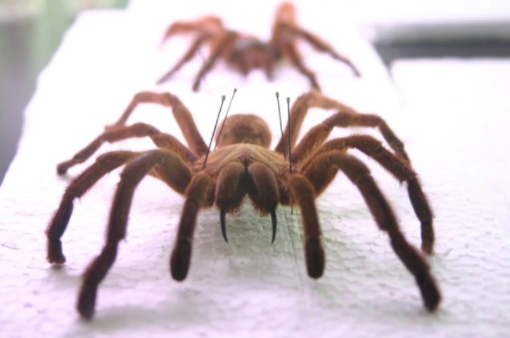
The Genius of Pinheads: When Little Brains Rule
for Scientific AmericanThe Samoan moss spider, the world’s smallest arachnid at a third of a millimeter, is nearly invisible to the human eye. The largest spider in the world is the goliath bird eater tarantula, which weighs 142 grams and is about the size of a dinner plate. For reference, that is about the same difference in scale between that same tarantula and a bottlenose dolphin.
And yet the bigger spider does not act in more complex ways than its tiny counterpart. “Insects and spiders and the like—in terms of absolute size—have among the tiniest brains we’ve come across,” says William Wcislo, a scientist at the Smithsonian Tropical Research Institute in Panama City. “But their behavior, as far as we can see, is as sophisticated as things that have relatively large brains. So then there’s the question: How do they do that?”
No one would argue that a tarantula is as smart as a dolphin or that having a really big brain is not an excellent way to perform complicated tasks. But a growing number of scientists are asking whether it is the only way. Do you need a big brain to hunt elusive prey, design complicated structures or produce complex social dynamics?
For generations scientists have wondered how intelligent creatures developed large brains to perform complicated tasks. But Wcislo is part of a small community of scientists less interested in how brains have grown than how they have shrunk and yet shockingly still perform tasks as well as or better than similar species much larger in size. In other words, it is what scientists call brain miniaturization, not unlike the scaling down in size of the transistors in a computer chip. This research, in fact, may hold clues to innovative design strategies that engineers might incorporate in future generations of computers.
Scientists interested in brain miniaturization often refer to something called Haller’s rule, proposed by German neuroscientist Bernhard Rensch and named for the 18th-century father of physiology, Albrecht von Haller. It holds that smaller creatures will have smaller brains but that the ratio of brain to body size will actually go up. And what is amazing is that few if any creatures on earth violate this rule. “It’s extremely general, and it’s been known for a long time. And there seem to be no good ideas as to why in the world it’s true,” says William Eberhard, a spider researcher and frequent collaborator with Wcislo, who also works at the Tropical Research Institute.
(For the full story click here)